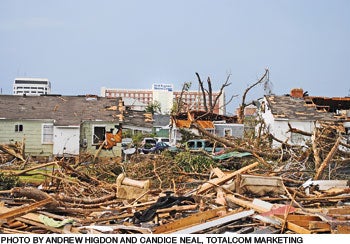Patient care prevails despite storm's wrath
 Prepared and trained leaders and staff were critical to ensuring that emergency-response plans were followed at three Alabama hospitals as deadly tornadoes tore through or near their towns on April 27.
Prepared and trained leaders and staff were critical to ensuring that emergency-response plans were followed at three Alabama hospitals as deadly tornadoes tore through or near their towns on April 27.
More than 340 died from tornadoes that ravaged parts of six states in the South. Alabama was the hardest hit with more than 200 reported dead.
The University of Alabama Birmingham (UAB) Hospital; Cullman Regional Medical Center; and DCH Regional Medical Center, Tuscaloosa, executed textbook-level response in implementing their emergency-preparedness plans.
No fatalities or injuries were reported at any of the three facilities and each successfully provided care and treatment for those who sought medical help after the storms and days following. Being ready made the difference.
"Practice and drilling and thinking through plans and the what-ifs were completely and utterly invaluable," says Janet Teer, vice president of legal affairs and general counsel, DCH Health Systems.
As head of the health care system's emergency-preparedness team, Teer directed the response at DCH Regional Medical Center from a command center similar to those activated at the other two facilities. From the center, she and her response team made sure hospital staff were alerted about the severe weather and the possible need to move patients to hallways for safety.
Teer also maintained communication with all departments to assess their readiness for an expected patient surge after the storm. A violent tornado came to within 200 yards of the facility and then veered away toward the town. Parts of Tuscaloosa were flattened, but the hospital incurred minimal damage.
DCH and its sister facility in Tuscaloosa treated more than 1,000 patients for storm-related injuries. Off-duty doctors and nurses volunteered their services. "I don't know that I've ever been prouder to wear a DCH badge," Teer says.
While Teer gives the hospital a grade of A for its response, the storm taught some important lessons. For example, the facility may need to beef up its emergency power grid, which worked well but did not provide adequate power for all departments, including imaging. More imaging equipment would have aided patient throughput, she says.
Arpan Limdi, associate vice president for facilities, UAB Hospital, says a tornado hit the town but stayed clear of the facility, which experienced no storm damage. As the only Level I trauma center in the state, the hospital prepared for a surge in patients. About 135 — most with acute injuries — were treated that night. "One thing that worked well: We had a game plan for a surge in our capacity. We had a plan to make sure we had adequate staff," Limdi says.
Jete Edmisson, chief financial officer, Cullman Regional Medical Center, was in charge of the emergency response.
As with the other two hospitals, Code Gray was issued as weather became more threatening. Edmisson activated the hospital's incident command center to communicate with staff, the area's emergency management system agency and other hospitals.
The tornado moved straight toward the hospital, but bounced over it, through the parking lot and away from the campus, Edmisson says.




